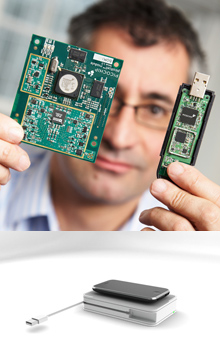Cellular base station in your pocket

Small USB devices that offer service to nearby cell phones provide fast Internet access and an alternative to expensive international roaming.
Your cell phone usually exchanges signals with a large transmitter a few kilometers away. Now he can do it at a shorter distance with a device the size of a flash drive.
Two British companies, PicoChip and Ubiquisys, have developed a USB-powered handheld device that connects to nearby mobile phones using the same frequencies as the traditional cellular base station. Gadgets use a computer or other device’s Internet connection to connect to a cellular network and transfer calls and data. PicoChip devices are as big as flash drives, while Ubiquisys devices are as big as small cellular phones.
These devices are “shrunken” femtocells — smaller cellular base stations that some mobile operators have been promoting the last couple of years as a solution for consumers with poor cellular signal at home. They are also increasingly seen as a way to increase the data link. Until today, however, femtocells were much larger, usually the size of a modem, and required their own power supply.
')
"This is the world's smallest 3G cellular base station," says Andy Gothard of PicoChip, which supplies chips for most femto cells sold in the world, including AT & T's MicroCell. PicoChip was able to reduce the size of the femtocell by redesigning the main chip and reducing the power consumption to 4.5 volts, which can be obtained from the USB connection, Gothard said. The latest generation of chips manufactured by the company have a size of 20mm on the side and are 65 nanometer technology. The new generation is a square 12mm in size and is manufactured using 40 nanometer technology.
“We have shown interest in companies that offer broadcast and cable television,” said Gothard. These companies could supply femto cells on behalf of wireless operators, and in return receive payments for using the Internet.
Ubiquisys, which supplies femtocell operators including Japanese SoftBank, has made a USB-powered femtocell to allow customers to bypass the high prices for international roaming. The device basically works in the same way as the PicoChip device, but has additional functionality that is responsible for meeting different requirements for using the frequency spectrum in different countries.
“When the device is connected to a computer, it uses a combination of methods — it listens on nearby base stations and checks IP addresses to see which country it works in,” said Kate Day, vice president of the company. The device needs to know where it is located in order to comply with local legislation on the use of the frequency spectrum and to avoid interference from other wireless devices.
"To meet the requirements, it can broadcast only at a very small distance," says Day, "perhaps even less than one centimeter." In this case, the user must put his phone directly on the lid of the device to establish a connection, and use a headset or speakerphone to receive and make calls. Prototypes that allow European phones to be used in the United States have already been developed and tested, says Day.
“Taking and putting the entire base station into a USB whistle is a significant step forward,” says Aditya Kaul, director of mobile networks at ABI Research. "They are cheaper, and more compact devices can be easier delivered to consumers and easier to install on their own."
The idea of Ubiquisys to use femtocell in different countries to avoid roaming prices, like users and operators, add Kaul. The user can avoid high roaming charges, and the operator will be able to receive payments for using the phone, which otherwise would not have been used at all.
However, significant regulatory difficulties remain unresolved. “Operators will need guarantees that such a device works legally, and the rules governing the use of the ether are very complicated,” says Kaul. “Careful agreements will be needed for each country.” Japan gives us a concrete example of such difficulties: there is a law requiring the installation of devices, such as a cellular base station, to be made by an engineer, and no matter how large the device is. “So today the device from Ubiquisys will not be able to work there,” says Kaul.
Source: https://habr.com/ru/post/113437/
All Articles